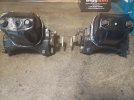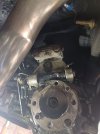GRTV8
Well-Known Member
A tight place to work in. Fond memories from doing the ignition/steering lock on the other side.
The soldering looks a little like how I do stuff. Could be good -could be shite.
I would look at tiding up those raw joins. In the past Ive used a liquid insulation in tight places to great effect. Comes in a small tube, semi fluid and hardens off upon contact with air, making a nice insulated join and giving peace of mind.
All fuses have been upgraded to blade type - a good move.
The soldering looks a little like how I do stuff. Could be good -could be shite.
I would look at tiding up those raw joins. In the past Ive used a liquid insulation in tight places to great effect. Comes in a small tube, semi fluid and hardens off upon contact with air, making a nice insulated join and giving peace of mind.
All fuses have been upgraded to blade type - a good move.







